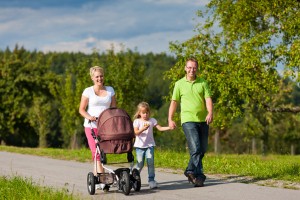
Choosing the right baby stroller is an essential decision for any parent, as it directly impacts daily convenience and your child’s comfort and safety. With a plethora of options available, understanding the ins and outs of baby strollers can help you make an informed choice. This guide will cover the different types of strollers, key features to look for, safety considerations, and tips for selecting the best stroller for your needs.
Types of Baby Strollers
1. Full-Sized Strollers:
These are versatile strollers designed for long-term use, typically from birth through toddlerhood. Full-sized strollers from sites like nunababy.com/au often come with a range of features, such as reclining seats, storage baskets, and compatibility with car seats for a complete travel system. They are sturdy and provide a smooth ride but can be bulky and heavy.
2. Lightweight or Umbrella Strollers:
As the name suggests, these strollers are lightweight and easy to maneuver, making them ideal for quick trips and travel. They fold compactly, often resembling an umbrella when closed, which makes storage easy. However, they may lack some of the features and durability of full-sized strollers and are generally suited for older babies and toddlers.
3. Jogging Strollers:
Designed for parents who want to maintain an active lifestyle, jogging strollers feature three large, air-filled tires and a suspension system for a smooth ride on various terrains. They have a locking front wheel for stability during jogging and a hand brake for added control. These strollers are often bulkier and heavier but provide excellent maneuverability.
4. Double Strollers:
Ideal for families with twins or multiple young children, double strollers come in two configurations: side-by-side and tandem (one seat in front of the other). Side-by-side strollers are wider and can be harder to navigate through doorways, while tandem strollers are longer but narrower. Both types offer convenience and the ability to transport multiple children simultaneously.
5. Travel Systems:
A travel system includes a full-sized stroller and a compatible infant car seat that can attach to the stroller frame. This setup allows you to move a sleeping baby from the car to the stroller without disturbance. Travel systems offer versatility and long-term use, as the stroller can be used independently once the child outgrows the car seat.
6. Car Seat Carriers:
These are lightweight frames designed to carry specific infant car seats. They are convenient for quick trips and easy transitions between car and stroller. Once the baby outgrows the infant car seat, a full-sized stroller or other option will be necessary.
Key Features to Consider
1. Safety Features:
Ensure the stroller meets safety standards and has a five-point harness to secure your baby. Look for sturdy construction, reliable brakes, and a wide base to prevent tipping. Reflective materials or lights can enhance visibility during low-light conditions.
2. Maneuverability:
A good stroller should be easy to push and steer. Swivel front wheels provide better maneuverability, while larger wheels handle rougher terrain more effectively. Test the stroller’s handling with one hand to ensure ease of use.
3. Comfort:
Your baby’s comfort is paramount. Look for padded seats, adjustable recline positions, and a canopy to protect against sun and rain. Ventilated seat fabrics can help keep your baby cool.
4. Foldability:
Consider how easy it is to fold and unfold the stroller, especially if you’ll be using it frequently or traveling. One-hand fold mechanisms are particularly convenient for busy parents.
5. Storage:
Ample storage space is important for carrying diaper bags, toys, and other essentials. Check for a large, easily accessible basket, and additional pockets or compartments can be a bonus.
6. Adjustability:
Features such as adjustable handlebars can make a stroller more comfortable to push, especially for parents of different heights. An adjustable footrest can also accommodate your growing child.
7. Weight and Size:
Think about how heavy and bulky the stroller is, especially if you’ll be lifting it into a car or carrying it upstairs. Lightweight strollers are easier to handle but may sacrifice some features and durability.
Safety Considerations
1. Certification:
Ensure the stroller meets safety standards set by organizations like the Juvenile Products Manufacturers Association (JPMA). Certification indicates the stroller has undergone rigorous safety testing.
2. Proper Use:
Always use the harness and never leave your child unattended in the stroller. Follow the manufacturer’s guidelines regarding weight and age limits.
3. Brakes:
Test the brakes to ensure they engage and disengage easily. Use them whenever you stop the stroller to prevent it from rolling away.
4. Stability:
Avoid hanging heavy bags on the handlebars, as this can cause the stroller to tip over. A wide base and low center of gravity enhance stability.
5. Maintenance:
Regularly check the stroller for wear and tear. Ensure wheels are secure, brakes function properly, and fabric is free of tears.
Tips for Choosing the Best Stroller
1. Assess Your Needs:
Consider your lifestyle and where you’ll be using the stroller most often. Urban environments might require a compact, maneuverable stroller, while suburban areas with rougher terrain may benefit from a jogging stroller or one with larger wheels.
2. Test Before You Buy:
Whenever possible, test the stroller in person. Check for ease of maneuverability, folding mechanism, and comfort. If buying online, read reviews and watch videos to get a sense of the stroller’s functionality.
3. Think About the Future:
Choose a stroller that will grow with your child and potentially adapt to future siblings. Convertible strollers and those that accommodate additional seats or attachments can be cost-effective in the long run.
4. Budget Wisely:
Strollers range widely in price. While it’s tempting to go for the most affordable option, investing in a higher-quality stroller can provide better safety, durability, and convenience. Look for deals and discounts but prioritize essential features and safety.
5. Consider Storage Space:
Ensure you have enough space to store the stroller when not in use. Some strollers fold compactly and stand upright, making storage easier in small apartments or homes.
6. Factor in Travel Needs:
If you travel frequently, a lightweight, compact stroller that’s easy to fold and carry can be invaluable. Some strollers are designed specifically for air travel and fit in overhead compartments.
7. Seek Recommendations:
Ask friends, family, and other parents for their recommendations based on real-world experience. Online forums and parent groups can also provide valuable insights and reviews.
Conclusion
Choosing the right stroller involves balancing your needs, preferences, and budget with the safety and comfort of your child. By understanding the different types of strollers and the key features to look for, you can make a well-informed decision that will serve your family well through the early years. Prioritize safety, comfort, and functionality to ensure that your stroller supports your lifestyle and provides a pleasant experience for both you and your baby.
